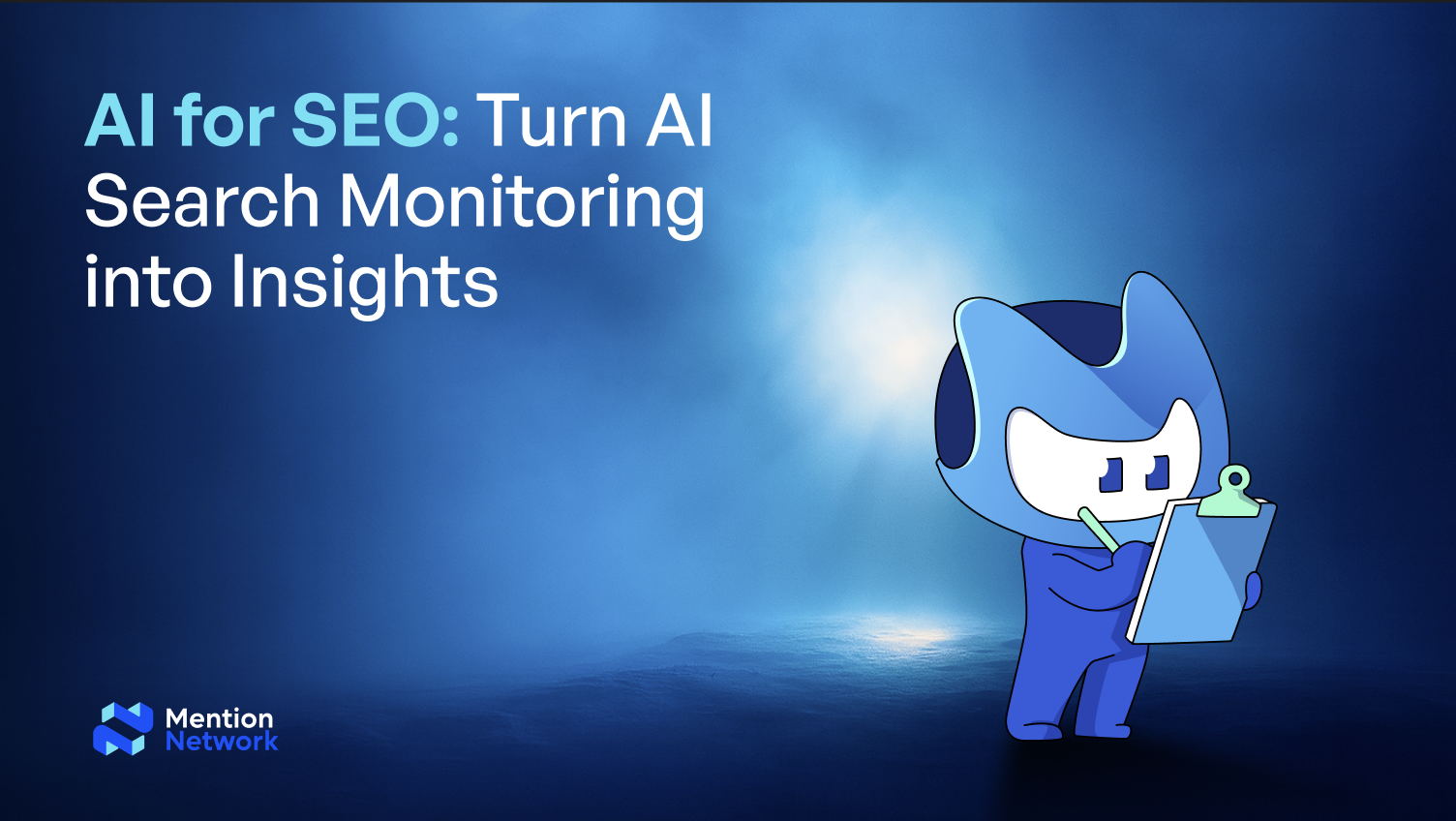AI for SEO: Turn AI Search Monitoring into Insights

The integration of generative AI into search engines marks the most significant shift in organic visibility since mobile indexing. Traditional SEO tools and metrics, designed for tracking link rankings and organic clicks, are increasingly inadequate. To maintain relevance and competitive edge, marketers, developers, and founders must embrace AI Search Monitoring. This new discipline provides the empirical evidence necessary to decode Large Language Model (LLM) behavior, translating raw citation data into precise, actionable insights for Generative Engine Optimization (GEO). The future of search demands not just better content, but intelligent, data-driven content architecture.
- Citation is the New Rank: Success is measured by Citation Frequency how often your content is chosen by the LLM, not just its position in the link list.
- AIS Defines Visibility: AI Impression Share (AIS) is the essential metric for understanding your visibility within AI-generated answers and overviews.
- Decipher Structural Cues: Monitoring reveals the LLM's preferred content structure (e.g., lists, tables, direct definitions), dictating how you must architect your pages.
- Validate Authority (E-E-A-T): Citation analysis empirically proves whether your E-E-A-T efforts (expert authors, factual density) are recognized and trusted by the AI.
- Close Citation Gaps: Use monitoring to pinpoint where competitors are winning the narrative, identifying immediate, high-priority content retrofitting opportunities.
- Data-Driven Answer-First: Insights should inform the precise length and clarity required for the Answer-First structure to maximize quotability.
1. Why Traditional SEO Metrics Fail in the Age of AI Search Monitoring

Standard SEO metrics like organic traffic and rank position are misleading in the generative era because they do not account for the zero-click phenomenon driven by AI-synthesized answers.
The core challenge for AI for SEO is the complete redesign of the search engine results page (SERP). When a Large Language Model (LLM) provides a comprehensive answer directly in a Google AI Overview (AIO) or a chat interface, the need for the user to click a link often vanishes. If your content is the source for that answer, you've won the visibility battle (a citation), even if the traffic report shows a zero-click event. Traditional tools, failing to track these citations, create a massive blind spot, leading to misdiagnoses of content performance.
Why it Matters
The difference between a Rank-centric report and a Citation-centric report is the difference between measuring potential reach and measuring actual narrative control. AI Search Monitoring shifts the focus from traffic acquisition, a transactional goal to trust validation, a strategic goal.
Common Mistakes in Reporting
- Misinterpreting Traffic Drops: A drop in organic traffic is often mistakenly flagged as a content quality issue, when in fact, it may signify a win: the LLM is using your content heavily, satisfying the user directly.
- Ignoring the Generative Slot: Failing to track the generative output means you lack data on your competitive presence in the most visible and authoritative slot on the page.
2. Converting Citation Frequency into Actionable Structural Insights
The raw data from AI Search Monitoring specifically high and low citation frequencies—is the primary guide for optimizing content structure and implementing the Answer-First methodology.
Monitoring allows you to see what the LLM is citing and, crucially, how that content is formatted. This reverse-engineering process is essential for AI for SEO. If a highly-cited piece of content is consistently presented by the AI as a bulleted list, that is a direct instruction for future content architecture in that topic cluster.
How it Works: Deciphering the LLM's Format Preference
- Monitor Output: Track your most-cited pages and the exact format the generative AI uses (list, table, direct sentence, etc.).
- Analyze Structure: Deconstruct the source page. For example, if the LLM quotes a direct sentence, check that sentence's position and clarity (the Answer-First principle).
- Prescriptive Insight: If your citation frequency is low, analysis of competitor citations will reveal the structural missing link.
- Insight Example: If the AI consistently synthesizes competitor answers into a comparison table, your actionable insight is: "Retrofit all commercial-intent pages with comparison tables and corresponding Schema Markup."
- Actionable Insight: The optimal length for a BLUF sentence is found by monitoring the length of the sentences the LLM most frequently lifts. This data fine-tunes your Answer-First execution.
3. AI Search Monitoring for E-E-A-T and Semantic Depth Validation

AI Search Monitoring provides the necessary empirical validation that investments in E-E-A-T (Expertise, Experience, Authoritativeness, Trustworthiness) and semantic depth are being recognized by the LLM and contributing to SEO AI success.
E-E-A-T is no longer an abstract concept; it is a measurable input for LLMs. By tracking the generative output, you can confirm whether the AI is recognizing and trusting your authority signals.
Why it Matters: The Credibility Link
If you invest time and resources into securing content from highly qualified authors with detailed credentials and corresponding Person Schema, you need to know if the LLM sees that effort. Citation monitoring provides that proof.
- E-E-A-T Validation: A high citation frequency for a YMYL (Your Money or Your Life) topic, paired with monitoring evidence that the LLM explicitly links to or mentions the expert author, validates your E-E-A-T investment. Conversely, if your expertly written content is not cited, the insight is that the technical signal (Schema, author page prominence) is broken, not the content quality itself.
- Semantic Depth Insight: If a user's complex, long-tail conversational prompt is answered using multiple interconnected concepts and your domain is the source, it proves your content achieved the required semantic depth and internal linking authority. Low citation for complex prompts signals insufficient depth or incomplete topic coverage.
4. Turning Competitive Citation Gaps into Prioritized Actions
Advanced AI Search Monitoring elevates competitive analysis by identifying Citation Gaps, generating high-priority tasks for content architects and ensuring resources are focused on winning the most valuable generative opportunities.
A competitive Citation Gap exists where a competitor is cited for a key conversational prompt where your content should logically be the authoritative source. This is the most crucial insight derived from monitoring, as it represents immediate lost visibility.
How it Works: The Retrofitting Mandate
- Identify Gap: Monitoring reveals that Competitor Y is cited for the prompt, "What is the best way to structure an enterprise data lake?"
- Analyze Competitor: Deconstruct the competitor's page cited by the LLM. Insight: They used a clean HowTo Schema and a direct, structured list of three key steps.
- Prioritized Action: Your page, which only ranks at #4, needs an immediate structural retrofit: implement the HowTo Schema, convert dense text into a numbered list, and ensure the BLUF sentence is extracted cleanly.
This process moves the entire SEO AI strategy from a general content calendar to a highly targeted, data-driven update cycle, maximizing ROI on content retrofitting. The ability to identify which content element the LLM prefers (Schema, table, list, or definition) is the key insight derived from effective AI Search Monitoring.
5. Integrating Monitoring and Reporting into the Continuous GEO Workflow

To ensure sustainable SEO AI success, the insights generated by AI Search Monitoring must be integrated into a continuous, agile Generative Engine Optimization (GEO) workflow, moving reporting from retrospective data to prescriptive action.
The ultimate goal is to create a closed-loop system where monitoring data directly dictates the content strategy. The reporting function transforms from simply tracking past performance to directing future content architecture.
The Prescriptive Reporting Framework
Reports should focus on answering three critical questions for the content, development, and marketing teams:
- What to Fix (Citation Gaps): Which 5 pages have the highest discrepancy between organic rank and citation frequency? Action: Structural audit and Schema update.
- What to Build (Semantic Gaps): Which 10 complex conversational prompts in our niche have low AI visibility across all competitors? Action: Build definitive, E-E-A-T heavy pillar content.
- What to Validate (E-E-A-T/Structure): Which pages have successfully increased AIS over the last month? Action: Replicate successful structures and E-E-A-T signaling across the site.
This continuous, data-led workflow is the engine of high-performance SEO AI. It ensures that every content update is a targeted response to the observable preferences of the generative models.
Conclusion: The Intelligence Layer of Search
The era of AI for SEO demands a level of precision and data-driven insight that only dedicated AI Search Monitoring can provide. By shifting the focus from outdated rank reporting to the core metrics of Citation Frequency and AI Impression Share, strategists gain the empirical intelligence required to decode the preferences of Large Language Models. This move from guessing at algorithms to observing generative outcomes is the foundation of competitive Generative Engine Optimization. Content architects who master this monitoring-to-insight workflow will not only safeguard their current organic visibility but will build the authoritative, quotable assets that dominate the future of search.
FAQ on AI for SEO Insights
What is the single most important metric from AI Search Monitoring?
Citation Frequency, which measures how often your content is directly quoted or linked as the source within an AI-generated answer.
How do I know if my E-E-A-T efforts are working?
By using AI Search Monitoring to track the generative output and confirming that the LLM attributes the content to your expert authors, validating the E-E-A-T signals.
What is an "Answer-First" structure based on monitoring?
It's content architected to place the most concise, quotable answer (often a BLUF sentence) immediately after the heading, with the optimal length determined by monitoring the length of sentences the LLM successfully lifts.
Why do I need to monitor conversational prompts instead of keywords?
Users interact with generative AI using complex, long-tail conversational prompts. Monitoring these captures the true user intent and reveals the precise content required for LLM citation.

